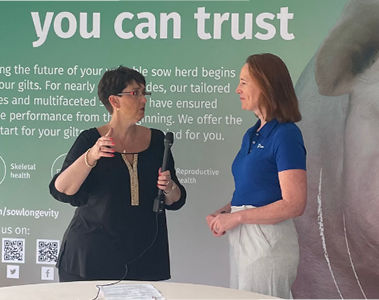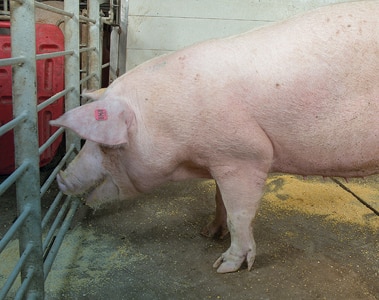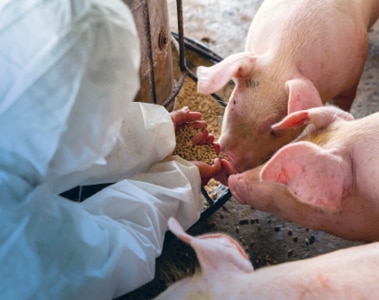Belkova, J., M. Rozkot. 2022. Gilt rearing impacts on sow performance and longevity – a review. J Swine Health Prod. 30(1):10-16.
Braña, D., J. Gabriel-Landon, J. Cervantes-Lopez, and J. A. Cuaron. 2012. Use of 25OHD3 favors opportune and sound bone maturation. J Anim Sci. 90(2):114.
de Koning, D. B., E. M. van Grevenhof, B. F. A. Laurenssen, P. R. van Weeren, W. Hazeleger, and B. Kemp. 2013. The influence of dietary restriction before and after 10 weeks of age on osteochondrosis in growing gilts. J Anim Sci. 91:5167-5176.
Lents, C. A., C. Supakorn, A. E. DeDecker, C. E. Phillips, R. D. Boyd, J. L. Vallet, G. A. Rohrer, G. R. Foxcroft, W. L. Flowers, N. L. Trottier, J. L. Salak-Johnson, F. F. Bartol, and K. J. Stalder. 2020. Dietary lysine-to-energy ratios for managing growth and pubertal development in replacement gilts. Applied Anim Sci. 36(5):701-714.
Long, T. E. 1998. Effects of gilt nutrition and body composition on subsequent reproductive performance. Swine Health Management Certificate Seminar Series released by Michigan State University Large Animal Clinical Sciences.
Muro, B., Carnevale, R., Leal, D., Almond, G., Monteiro, M., Poor, A., Schinckel, A. and Garbossa, C. 2022. The importance of optimal body condition to maximise reproductive health and perinatal outcomes in pigs. Nutr. Research Reviews 1-21.
Nikkilä, M. T., K. J. Stalder, B. E. Mote, M. F. Rothschild, F. C. Gunsett, A. K. Johnson, L. A. Karriker, M. V. Boggess and T. V. Serenius. 2013. Genetic associations for gilt growth, compositional, and structural soundness traits with sow longevity and lifetime reproductive performance. J Anim Sci. 91:1570-1579.
Quinn A. J., L. E. Green, P. G. Lawlor, L. A. Boyle. 2015. The effect of feeding a diet formulated for developing gilts between 70 kg and ~140 kg on lameness indicators and carcass traits. Livest Sci. 174:87-95.
Rozeboom, D. W. 1999. Feeding programs for gilt development and longevity. Proc. Minnesota Nutr. Conf. 60:151-170.
Sørensen, M. T., C. Farmer, M. Vestergaard, S. Purup, K. Sejrsen. 2006. Mammary development in prepubertal gilts fed restrictively or ad libitum in two sub-periods between weaning and puberty. Livest Sci. 99:249-255.
Stalder, K. 2020. Awardee Talk: The Genetics of Sow Longevity. J Anim Sci. 98(4):28.
Stalder, K. J., M. Knauer, T. J. Baas, M. F. Rothschild, and J. W. Mabry. 2004. Review Article: Sow Longevity. Pig News Inf. 25(2):53N-74N.
Sugiyama, T., S. Kusuhara, T. K. Chung, H. Yonekura, E. Azem, and T. Hayakawa. 2013. Effects of 25-hydroxy-cholecalciferol on the development of osteochondrosis in swine. Anim Sci J. 84:341-349.
Tsai, T., B. Sam, N. Davis, H. Grogan, J. Bergstrom, K. Coble, U. Orlando, S. Hough, K. Blake, S. Dritz, C. Vier, and C. Maxwell. 2023. Longitudinal investigation of nutrient intervention during gilts development on sow reproductive performance and longevity. Abstract and presentation at the Annual Midwest Section Meeting of the American Society of Animal Science, Madison, WI.



